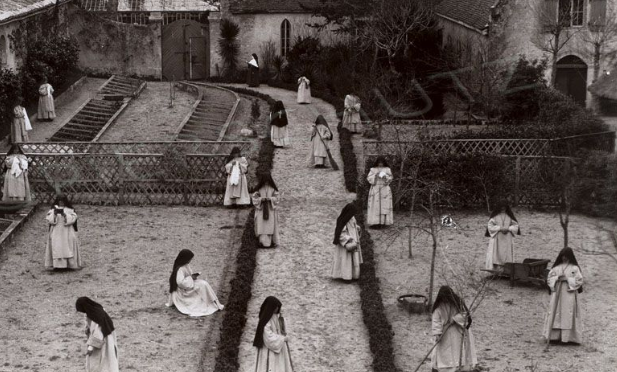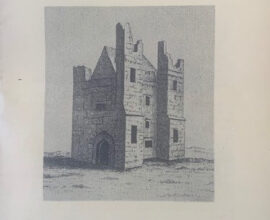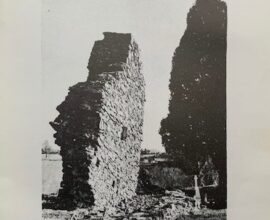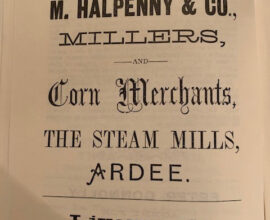Carmelite Order in Ardee – 13th Century
I have shown previously how the Monastic order of St John came to Ardee in 1207 and, in the coming centuries, set up Monastery and Hospital on the lands South of the River Dee stretching from Moore Hall in the East right over to Currabeg in the West.
This was not the only Monastic Order to set up in Ardee because, in 1274, the Lord of the Manor, Ralph FitzNicholas Pippard, brought the Carmelite Order to the town.
Expansion of the Monestery
Whereas the Carmelites, who first appear leading an eremitical life on Mount Carmel in the Holy Land, began to move across Western Europe from the first half of the 13th century. Their mode of living changed during this migration until they came to be reckoned as mendicants. In due course they made their way to Ireland and one of their first foundations in Ireland was at Ardee.
At first their monastery was small with only a couple of acres to the east of the town. Through time, however, their property expanded due to the many generous grants of houses and land made by Ardee townspeople. One of these particular grants serves to illustrate the governmental red-tape that existed in 14th century Ireland. It concerned a single acre of land that the townspeople of Ardee gave to this new order out of the Common land of Ardee. Because the King who effectively was the lord of the manor at that time, there ensued a very lengthy lawsuit concerning this single acre.
The end result was that, no matter that the townspeople of Ardee did not have the right to give the one acre away, the Carmelites were allowed to retain the acre as it was found not to prejudice the kings interest. They were, however, severely reprimanded for accepting it in the first place.
In 1329 the Carmelite monastery was again in the news when twenty-two of the Earl of Louth’s soldiers, who were visiting Ardee, on 9th June 1329, got very drunk and boisterous. They apparently destroyed a very important lime kiln and, when Robert Godeknave, a citizen of Ardee, began to remonstrate with them, the soldiers killed him. The resultant Hue and Cry saw the soldiers chased through the streets of Ardee by very irate townspeople, who caught up with two of the soldiers and killed them on the spot.
The remaining twenty soldiers took refuge in the Carmelite church but, so incensed were the Ardonians that the very next day, Saturday 10th June, they dragged the soldiers out of the chapel and killed them also.
On 11 November 1331 the king, Edward III confirmed the original grant made to the monastery by Pippard and, to further secure their property, in 1344 and 1345, the Carmelites paid five marks to the King for full and final confirmation of their original charter.
There is an interesting relict still in existence of this Ardee Monastery. It consists of a seal with the device of Our Lady with Divine Infant in her arms.
This particular seal was attached to a document dated 18 April, 1372.
Indenture made on Sunday before St. George’s Day, 46 Edward III, between the prior and brethren of Blessed Mary of Mount Carmel of Ardee of the one part and Walter Gernon of the other part, whereby the prior and brethren demised in farm to Walter all the messauges, lands etc that they have for a certain term of years from the aforesaid Walter and others, as in a writing perfected to them thereof is more fully contained; to hold in the form following for 56 years from date of these presents: viz. while the friars wish to till and tend (manu operare) the arable lands for their own use, such lands shall remain with them; or if John Keppock of Ardee wishes to have those arable lands in farm from them he shall have them for other lands nearest to them in Ardee. For all the lands, if he has them all, Walter will render 20s a year, and to the chief lords of that fee and all others whomsoever the services and other charges. If the arable land or a parcel of it remain with the friars or be demised to Keppock, Walter will render of the 20 shillings a sum proportioned to so much of the land as remain in his hand. Sealed by the parties alternatively.
The Carmelite Order in Aree
Throughout the 14th century several provincial chapters of the Carmelite order were held at Ardee. In 1504 the Carmelites played host to a Synod of diocesan clergy which was originally to have taken place in Drogheda. However, as the plague had broken out there, the clergy thought it safer to meet in the chapel of the Carmelites at Ardee. As the plague had also reached Ardee the location of the meeting was carefully chosen as the Carmelite chapel lay outside of the walls of Ardee. The clergy felt safe that they were convening their meeting outside of the town boundary. This provides a very useful and important clue in narrowing the possibilities as to the location of the monastery. (More about that in a later posting).
Like the Monastery of St John, the Carmelites played a large role in Ardee life until both of the Monasteries were suppressed by King Henry VIII in 1536 (more about that in a later posting).
While the order of St John were never heard of again in Ardee the same is not the case for the Carmelite Friars who returned to the town in 1637. By this year, however, the Carmelite order had split over ideological and theological differences into what were then termed the Calced and Discalced Carmelites.
The Calced Friars
It was a priest and brother of the latter who returned to Ardee in November, 1637. Father Michael of Saint Victor (Peter Corvin) and Brother Columbanus (Bernard Maginn), a student, who had recently completed his studies and who was waiting to be ordained. In the Annals of Carmel, particular mention is made of the fervour Father Victor and Brother Columbanus from the hour of their arrival in Ardee.
They set about rebuilding the monastery but less than a year later, were disturbed in their efforts when Bernard Matthews and Father Marcus de Castro, members of the Calced Carmelites, appeared in the town just before Easter, 1639. They immediately demanded that the monastery be handed over to them. Father Columbanus and Brother Victor refused to hand over the monastery and this refusal precipitated a dispute that was not only to involve the Ardee Corporation but also the Pope in Rome. Father de Castro took the matter to the Ardee civil authorities and, on 1st July 1639, Garret Colley, the Portreeve of Ardee, made a lengthy address on the matter.
At the request of R.P Marcus de Castro, of the Order of the B.V.M. (of Ancient Observation), I bear witness to what I know concerning the advent to Ardee of R.P. Bernard Maginn (otherwise P. Columbanus). As soon as the aforesaid Father expressed his intention of remaining amongst us, I, with others of the townsfolk, told him that we considered the Order of Discalced Carmelites to be both holy and worthy of our help; but not to the prejudice of a third party, namely, the Carmelites of the Ancient Observance to whom we had been united by an earlier bond. The aforesaid P. Columbanus, on his own behalf and on behalf of his order, told us he had come by the permission and counsel of the General of the Calced Friars, with power to enjoy all their rights and emoluments; and on the express condition that, as soon as the Calced Friars would be ready to return, the Discalced Friars would abandon the field.
They also enlisted the help and support of Hugh O’Reilly the Archbishop of Armagh who, on 15 August 1639, travelled to Ardee and, in front of a very large crowd of Ardonians, pronounced a sentence of excommunication against the Discalced Carmelite friars who had initially returned to Ardee. He also instructed that their chapel should not be used by any Ardonians until the matter had been fully resolved.
Father Victor of St Michael
In 1639, having made my profession in Dublin, I was sent under obedience by Father Simoen of Saint Teresa at that time vicar provincial, to our foundation in Ardee in County Louth, which is part of the province called Meath. Father Victor of St Michael (alias Peter Corvin) was then vicar of that foundation which afterwards became the convent of the Annunciation.
In 1639, then, Father Victor was continually labouring in preaching the word of God and for the salvation of the souls, even though the scourges and cruel threats of heretics beset him on every side. About Pentecost of that year he reconciled to the true Church of God and the obedience of the Roman Pontiff a Lutheran minister possessed of many benefices along with his eldest daughter. These made public detestation of all heresy and errors in the presence of certain prelates and the whole population, who with great joy had come to witness the unusual spectacle.
As Columbanus and Michael had virtually rebuilt the monastery they were not going to lose it so easily. The rebuilt monastery had come to be known as ‘The Convent of the Annunciation’. They appealed to Rome who intervened on their behalf and announced that it wished for them to keep the Ardee Monastery and that the Calced Friars should leave them in peaceful occupation of the monastery in Ardee.
Once this dispute was finally settled in early 1641, local Ardonians gathered around the friars and produced vestments, chalices and other items that they had faithfully kept hidden since the monastery had been supressed over 100 years before. These items, of course, were what the Kings men had been looking for during the suppression of the Monasteries in the 1530s. Father Columbanus has left us an account of looking after Ardonians at that time.
A month after the vicar’s conversion, Father Victor approached the keeper of an inn, resorted to by heretics, and himself known to be a most obstinate heretic and brought him and his wife into the fold of Christ and the security and faith of the Roman Church. In the following year, 1640, very many followed them. The Innkeeper’s daughter, called Mary King with his son eighteen years of age were reconciled by the same Father; and as well, certain nobles, namely Samuel Foster with his sister Elizabeth, abandoned heresy and embraced the Roman faith.
In consequence of this the wrath of the heretics was aroused against the Father; because in the same Inn where in their eating and drinking they had been accustomed to make little of God and the mysteries and ministers of the true Faith, they now saw everywhere the cross which was abhorrent to them and the foreheads of the innkeeper and his family sprinkled with holy water. So, in that same Inn that had formerly sheltered so many murmerers against the true faith. But the outcome of all this was that through fear of the anger of the heretics, Father Victor was obliged to take flight to another of our convents. When he left the care of these converts fell to me, though only a recently ordained priest, and, with the bishop’s leave, I heard their confession, and refreshed them each month with the sacred food of the Lord’s Body. After some time, two of the sons of the said minister approached me, and when I saw them well disposed towards the faith, youthful priest though I was and little versed in spiritual matters, I converted these young men from satellites of the devil to recruits for God in his church militant. So when they made public detestation of all heresies in the presence of the chaplain of that town and of certain nobles, I absolved them. Seven others also in that same year and in the beginning of the following year were by me reconciled. And then I set out for Malta.
Father Malachy of Jesus
When Father Victor had been forced to leave Ardee, he was replaced by Father Malachy of Jesus who was a local called John Dowdall.
The day to day labours of the monks in the Ardee Monastery are known to us from a journal kept by Father Arthur.
‘Rising at an early hour – before dawn – they recited part of the Divine Office, and afterwards passed some time in mental prayer. Father Victor then said Mass (formal possession of the new foundation could not be taken until the Blessed Sacrament was placed in the Tabernacle). By seven o’clock, or a little later, the Friars were free to devote their attention to the repairing of the ruined abbey. Were they not so occupied, they might have retired to their cells for study. Working hard with the labourers sent to assist them by some thoughtful friends, they had to retire before noon in order to continue the Cannonical Hours, and to make the midday examination of conscience. Now, for the first time that morning, they might break their fast – presupposing they had already obtained food for an exceedingly meagre meal. A brief recreation followed; it was spent, no doubt, by Father Victor and his young companion in the further improvement of the new ‘Home’. If the priest had not been called away to discharge the functions of his sacred ministry in the meantime. Vespers were said at two o’clock, various duties occupying the remainder of the afternoon until the evening Meditation. After Complain they partook of a frugal collation, then other monastic exercises were gone through were they might take a much-needed rest. But neither the tolls nor anxieties of a day thus passed could hinder them, once they were free, spending a few hours in the study of Theology, Holy Scripture or Canon Law; of course this meant a curtailment of the repose, which was to be interrupted at midnight for recital of the Matins of the morrow. (this was translated from the Latin in Rushe Carmel in Ireland pages 73 and 74)
The returned Carmelites did not enjoy the fruits of their labour for long as their stay in Ardee was cut short when the town was taken by English forces in 1642. This storming of the town at this time was to have enormous consequences not only for the Carmelite Friars but also for the majority of Ardonians. These consequences were stated in a letter they wrote to Rome on the eve of their departure where they said that Ardee was burned by the English and nobody lives there anymore.
The final chapter of the association with the Carmelites with Ardee was when brother Stephen, who had secretly remained in the town, died there in 1671 while there is also evidence in the Roman archives that they were in Ardee as late as the 1730s.
Further reading;
James P Rushe, Carmel in Ireland: a narrative of the Irish Province of Teresian or discalced Carmelites AD 1625-1896 with a supplement chiefly from the letters of Irish missionaries of the seventeenth century’ (Dublin 1903.),
Diarmuid MacIomhair, ‘The Carmelites in Ardee’, LAJ., XX, (1983), pp 180-189




